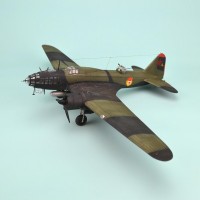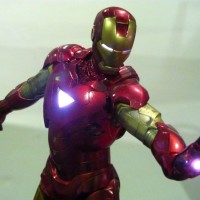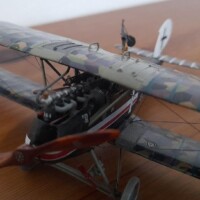A “Bad Project”.... I correct: a Bat Project: Howard Hughes Beoing 307 Stratoliner or a metamorphosis in four acts!
“Metamorphosis” is the beautiful word to describe a far-reaching transformation or complex redesign. Why am I writing this here? On closer examination of the eventful history of the Boeing 307 Stratoliner, I came up with this term: it really stuck when I looked into the fate of the Stratoliner presented here in the model: the aircraft represents the legendary Stratoliner NX19904 “Flying Penthouse” of multimillionaire Howard Hughes. This Stratoliner has survived to this day and is still in use in a heavily modified form. The “Flying Penthouse” has changed its shape in a most astonishing and probably irreversible way - I will come back to this later!
About the Boeing 307 Stratoliner
Only ten examples of this four-engine luxury airliner were to be built, although the driving idea behind it was certainly forward-looking and promising. The time was clearly ripe to take civilian passenger aviation to the next level: In the mid-1930s, the US airlines Pan American Airlines, United Airlines, Eastern Airlines and Transcontinental& Western Airways reached a contractual agreement with the Douglas Aircraft Company to invest in the development and construction of a large four-engine passenger aircraft. In the medium term, this project was to result in a successful aircraft that would also become a legend: the Douglas DC-4.
However, after the development of this machine proved to be unexpectedly lengthy and initially problematic, TWA pulled out of the contract in the same year. The fact that a new and tempting prospect had opened up for this company was motivating! At the instigation of Donald Webb Tomlinson, who was at home at TWA not only as chief test pilot but also in senior management, plans were made to invest in another project that seemed to promise a quicker solution.
Tomlinson, already one of the most experienced high-altitude pilots before joining TWA, set new and quite visionary specifications: the new aircraft was to be stratospheric-capable in order to be able to reach its destination quickly and safely by flying above the unpredictable weather conditions. In addition to the use of altitude-compatible engines, this meant above all the development of a pressure-resistant fuselage.
Tomlinson's ambitious specifications were based on a specific background: at the time, he was test-flying the new Boeing XB-17. At his instigation, TWA commissioned Boeing to turn the future four-engine bomber into an airliner that would carry passengers comfortably to their destinations in a pressure-resistant fuselage at an altitude of at least 5,000 meters. In 1935, the Boeing Model 299 Flying Fortress was turned into the Boeing Model 307 with the well-deserved name “Stratoliner”. The wings, tail unit, engines and landing gear were taken over completely and unchanged from the XB-17, only the fuselage was newly created as a cylindrical pressure hull. Metamorphosis I was complete: the four-engine bomber design had been transformed into a stratospheric passenger aircraft.
The development of the pressure-tight fuselage was potentially dangerous new territory, and the development process, which lasted several months, was accordingly cautious. However, this does not mean that they did not proceed with rather shirt-sleeved means. For example, you can imagine that the pressure-tightness was checked in a similar way to how you would check a broken bicycle inner tube: the Boeing workers soaped the pressurized, shimmering aluminium fuselage with soapy water and carefully checked whether air bubbles would form at the seams!
The maiden flight of the new aircraft went off without a hitch in December 1938.
However, this first Boeing 307 with the registration NX19901 tragically crashed in March 1939. All ten occupants were killed when the aircraft first went into a spin while attempting to fly at high altitude and, after successfully recovering, lost both wings due to the high speed reached. The investigation into the accident revealed that the vertical stabilizer was too small. One of the subsequent modifications was to have far-reaching consequences for the appearance of the Boeing Stratoliner: the newly designed enlarged vertical tail was not only fitted as standard to the Stratoliner under construction, but was also retrofitted to the two existing aircraft. The contour of the new tail unit was drawn down to the front of the fuselage with an elegant sweep. The same modification was also introduced on the B-17 Flying Fortress of the E series, which went into series production in 1940, which not only gave the bomber legend its well-known iconic appearance, but also impressively demonstrated the close technical relationship between the two designs.
After acceptance and entry into service, four of the Stratoliners went to PanAm, which, along with five Boeing 307 Stratoliners delivered to TWA, were used for a short time in their original role as luxury high-altitude airliners. The pressurized fuselage with a diameter of 3.5 m offered comfortable space for 33 passengers in a sumptuously furnished ambience. The cabin interior still impresses today in contemporary images with its technical sophistication and stylistic solidity: no wonder, as star designer Raymond Loewy had been contracted by TWA for this task.
The Stratoliner as C-75 in military use
The reason for “Metamorphosis II” was the USA's entry into the war: TWA's five Stratoliners were requisitioned for the war effort: the USAAC/USAAF needed long-distance transporters for freight and higher-ranking personnel for the global war. The Stratoliner, known as the C-75 in military use, lost its luxurious seating, the wash areas and the acoustic insulation of the interior. Instead, the military radio and navigation equipment was added, bringing the former civilian Stratoliner up to the military standard of the time. After three years of intensive use, the five C-75s were sold back to the TWA by the USAAF, where they were restored to their former civilian configuration before being used in long-haul operations for a few more years. In summary, however, it can be said that the war years prevented the Boeing 307 from realizing its potential on a large scale. During the war, the need for luxuriously equipped civilian flights in the States declined - and after the war, the world had changed: the future of emerging passenger traffic was to belong to the passenger jet.
About the model seen here: Howard Hughes Stratoliner NX19904
Metamorphosis III: Those of you who have been counting may wonder what happened to the one aircraft that remains if you subtract the five delivered to TWA and the four to PanAm from the total number of ten Stratoliners produced. This is where Howard Hughes comes into play.
Hughes was one of the first customers for the Boeing 307: in July 1939, he bought NX19904, one of the first two Stratoliners built - and therefore still without an enlarged tail unit and without a modified wing tip - in order to have it fitted with additional tanks for a record round-the-world flight. Hughes wanted to beat his own record: from July 10 to 14, 1938, he had already circumnavigated the globe in a Lockheed Electra, and now he wanted to set a new record in a somewhat more luxurious environment. At the end of August 1939, everything was ready - but even a Howard Hughes could negate the new circumstances created by Hitler's invasion of Poland.
Following the canceled round-the-world flight, Hughes had the aircraft parked in Glendale, California, converted into a flying luxury apartment at great expense. The end result of this design and equipment revolution included a bedroom, two bathrooms, a galley and its own bar: Stratoliner NX19904 had become “The Flying Penthouse”. In 1949, Hughes decided to get rid of this flying jewel: an extensive renovation and refurbishment - again under the direction of designer Raymond Loewy - was intended to make the unusual one-off attractive to oil millionaire Glenn McCarthy. The aircraft was repainted and renamed “Shamrock”, but the agreed payments were not made and the aircraft was returned to Hughes. NX19904 remained unflown for the next few years until 1965, when a passing hurricane devastated it to such an extent that the remains could only be described as a wreck. It was subsequently purchased for little money by Kenneth W. London, who had his own ideas for the former stratosphere conqueror: he had the fuselage, stripped of its wings, placed on a ship's underbody so that it could be used as a kind of houseboat!
Metamorphosis IV: Hughes Stratoliner as “Cosmic Muffin”.
In 1981, Dave Drimmer acquired the unique construction in order to continue using it as a “planeboat”, but also to give Hughes' former Stratoliner back its inner values and a little of its outer dignity. Drimmer's Stratoliner hull, renamed “Cosmic Muffin”, now features a dignified and luxurious interior reminiscent of its golden age, with a bed, lounge and bar. The cockpit, on the other hand, still has the original fittings. The “Cosmic Muffin”, which is still operated as a houseboat today, is one of the last two surviving examples of this unique aircraft, alongside the NX19903 on display at the Smithonian, Washington! I can really recommend taking a look at the unique appearance of the “Cosmic Muffin”/ Stratoliner NX19904 online; I'm sure you'll be amazed and astonished!
About the kit and building process
It is not for nothing that we know the saying that we should not use many words, but “let the pictures speak”. When describing the kit parts and, as a result, the building process, I would like to make use of this idea. If I were to start listing all the weak points, challenges and impositions, not only would a lot of text loaded with negative criticism be used up, but also nothing would be said that could not also be communicated with the construction photos.
To make a long story short: I recommend this adventure to anyone who has been infected by the fascination of the Boeing 307 Stratoliner and would like to own a model of this impressive aircraft in 72 scale - but only to those! You should allow for time, energy, ingenuity, perseverance and a high frustration threshold thanks to good motivation. Packs of sandpaper, quantities of filler and containers of cyanoacrylate adhesive were my faithful and constant companions during the relatively long construction period - I had to put the project aside for a few weeks to regain energy for it.
So that this review doesn't end too negatively, I can say the following: I already have a second kit ready to build another Stratoliner as a C-75 military variant. After the experiences with Howard Hughes's prevented round-the-world plane feel prepared and motivated to face another Boeing 307 of the “Bat-Project”, because: all in all it was fun!































Great effort and in the end beautiful result... the stories concerning Hughes are always very fascinating...
Thank you very much! You've addressed something that really applies to Howard Hughes
, Fabulous work! What kit or kits did you use? @rosachsenhofer
Thank you for words and your interest Dale! The Ukrainian manufacturer “Bat Project” has a few, quite expensive but also interesting kits on offer. The Boeing 307 Stratoliner is one of them, available in four kits with different markings. This one is kit no. 72011
Amazing to see how you turned this kit into such a wonderful Stratoliner, Roland @rosachsenhofer
Your perseverance clearly won over the numerous issues this kit has.
Well done.
Thank you very much for your motivating words John - much appreciated!
What a wonderful result out of this challenging kit, Roland!
Excellent article!
Congratulations!
I'm glad you like the pictures and articles, thanks Spiros!
Very nice work as usual and a superb result.
When I caught the Freedom Bird in Bangkok for trans-Pacific transportation back to the Big PX, the Boeing 707 stopped at Tan Son Nhut to pick up the rest of the passengers. I was looking out the window as we taxied across the ramp to the main runway, and saw an airplane only I of those aboard could identify - a Boeing 307. It had the big B-17E tail. I later read that it had been operated by Air France during the First Indochina War. It was supposedly (but unproven) used by Can't Investigate Anything during the second war. Most distinctive shape I ever saw on an airport ramp.
Tom, thank you for your valued feedback! I'm always amazed at how broad your experience of flying is and what interesting stories you can share - thanks for that too!
Kudos for all the elbow grease it took to tame this kit! She really turned out nice.
Thank for these appreciated words!
What an awesome project and interesting story. Your photos are worth a thousand words, it looks like one of those limited run kits where "previous modeling experience" would be helpful.
A little over 20 years ago I had the opportunity to see Stratoliner N19903 depart Paine Field for its return to Boeing Field during a test flight after its restoration. Later that evening I saw it on the local news - it had run out of fuel on it's return to Boeing Field and gave some diners in a restaurant overlooking Elliot Bay a quite a show by landing in the water. Fortunately, it was close to shore and the water was shallow. It sustained relatively minor damage, was repaired, and eventually flown across the country to the Smithsonian where it now resides. So, two of the Strtoliners ended up in the water - one more successfully than the other
3 attached images. Click to enlarge.
Thank you - and what a most amazing story you tell! I knew the pictures of the Stratoliner ditching in the water, but a report from someone who was so close is new to me!
How true... a watery last chapter for both of them!
I caught a glimpse of it in the hangar in Boeing's plant 2 before the ill-fated test flight. The flight crew didn't pay attention to the fuel gage. The entire electrical system had to be replaced, and, you are correct, there was little other damage.
I like the finish! Very realistic. Any tips on accomplishing that. An aspiration for me...
Thank you for these kind words!
Nicely done Roland, unusual subject.
Thank you Allan, very appreciated!